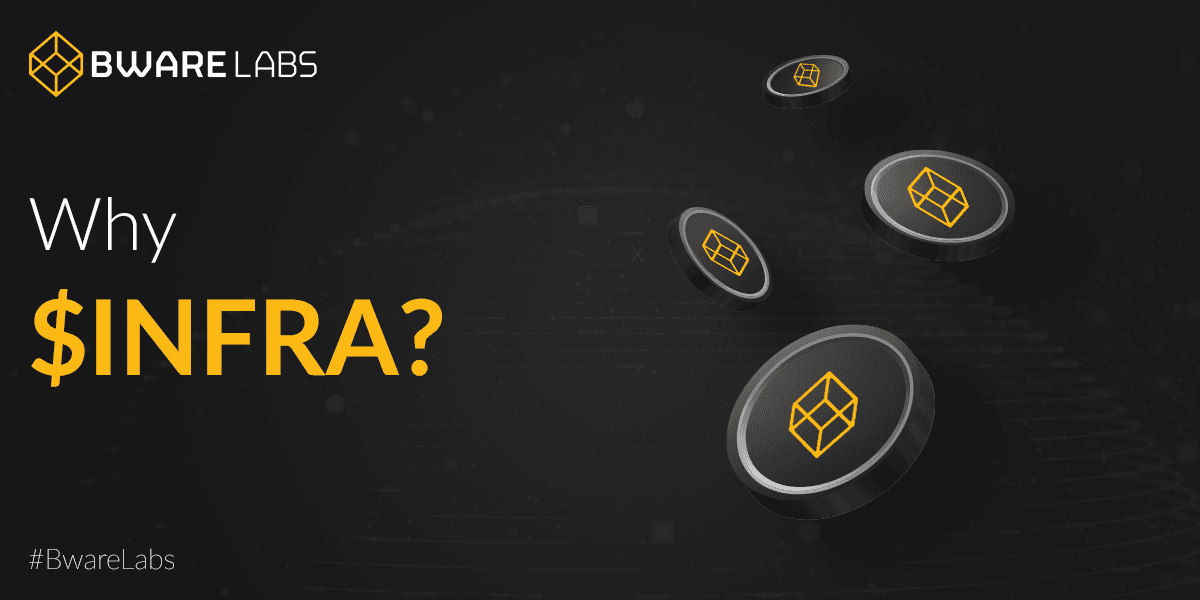
INFRA – A utility token and the token utility
Bware Labs Team
The purpose of this article is to provide a clear picture of what the Bware token ($INFRA) is, and what are the industry issues that Bware Labs is trying to address that are powered by its token. Read through for an 8-minute explanation of why you should be part of the $INFRA story.
What is the $INFRA token and why the ticker?
As the name suggests, the $INFRA token was created as a way to facilitate easy and cost-effective access to blockchain infrastructure. While the excitement of the Web3 world relies on millions of decentralized applications and hundreds of blockchains, one crucial, yet often overlooked, component is blockchain access. For dApps to be connected to the blockchains they are running on, most of the time they need to go through an API provider, and most of the time, those providers are centralized.
A lot of people struggled with the idea that there is always a centralized point in any decentralized application’s architecture so a new concept started to emerge: decentralized blockchain infrastructure, sometimes referred to also as dePIN (decentralized physical networks).
But even before that concept was a thing, as engineers working in the Web3 space, the founding team of Bware Labs observed the necessity of decentralized infrastructure and started designing what has become the highest-performing decentralized API provider in the entire Web3 space: Blast.
Blast is a multichain API platform that comes with the performance required to successfully run enterprise-grade dApps, all while being itself decentralized. Blast relies on a protocol that leverages the capabilities of hundreds of third-party node operators, a smart routing algorithm, and a performance monitoring system to provide highly available, high-speed blockchain access to over 30 chains.
In order for such a protocol to exist and function correctly you need both an incentivisation mechanism as well as a regulation system in which performance and availability are rewarded accordingly so that’s how the $INFRA token appeared. It is an integral part of the Blast platform and protocol and its purpose is to change the way, Web3 builders think about blockchain infrastructure.
Given its role in powering a unique decentralized infrastructure service, the choice of its ticker, $INFRA, was clear from the beginning.
The role of $INFRA in the Blast ecosystem?
As explained in the section above, Blast relies on its third-party operators to provide a top-tier service to its customers.
In order to become a Blast operator, companies as well as individuals will have to register at least one blockchain node within the platform and go through a performance verification process. If the process is completed successfully their node becomes active in the set of Blast nodes and starts serving blockchain requests. But, how about incentivization?
Well, all operators that own active nodes within Blast, have the opportunity to create a staking pool for each of their nodes. The staking pool creation requires a minimum of 5000 $INFRA to be self-staked and once it is created, the operator starts to receive an APY that ranges from approximately 9% to 15%. Still, this might not be enough to cover all operational expenses and this is where the $INFRA holders come in. All staking pools can set a commission and accept delegations from any $INFRA holder so that they can cover the costs of their infrastructure and maintenance.
The amount of rewards that each delegator receives depends on the size of the operator commission as well as the operator’s overall performance as the performance is factored in during the computation of each epoch’s (24hrs) APY. That’s how Blast manages to keep its performance standards even though decentralized.
What can I do with $INFRA as a holder?
If you own $INFRA, depending on your engineering skills and available infrastructure access you can either run a Blast node and create a staking pool or you can simply delegate to one of the existing ones.
Running a node and creating a Blast staking pool can be done by anyone who already owns a blockchain node since Blast’s routing system takes into account the load on each node when sending requests to it.
If you do not know how to run a node, that’s ok. You have the option to delegate your $INFRA holdings to one of the available staking pools directly from the Blast Explorer using your Metamask wallet.
The Blast Staking Protocol is deployed on Avalanche so if it’s not completely clear how to bridge your tokens to delegate them, the Blast team has prepared a short tutorial for you.
Going into the future
As you have probably already guessed, the $INFRA story is far from over. Given the amazing performance of the Blast platform and its decentralized nature, we are setting up to become a middle layer for blockchain access. This means that aside from decentralized apps, Blast has become fully equipped to provide blockchain data to the full spectrum of the Web3 technology stack, from indexing companies to analytics companies and even other RPC providers, they all can and are using Blast as a data source.
More chains will come to Blast as the platform expands, and more slots for creating staking pools will become available.
$INFRA payments will be made available allowing builders to obtain serious discounts while contributing to the Blast journey.
Conclusion
As we are preparing for the mass adoption of Web3 into the real world, the quality of Web3 products will always be tied to the quality of the infrastructure they run on. Not only the blockchain itself but also blockchain access will become increasingly important to make decentralized applications as good in terms of availability and user experience as the centralized ones. We cannot speak for the blockchain scalability or performance, but we can guarantee that access will never be the bottleneck in the equation and the $INFRA token plays an important role in that! Build On!

